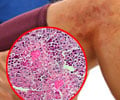Scientists have identified a new treatment “target” to help the asthma sufferers, following their research on white cells that cause the symptoms experienced by asthma patients.
Scientists of Cincinnati have found out a new treatment “target” to help millions of asthma sufferers in U.S. The results were reported following their research on certain white cells in the body that played a major role in the cause of symptoms experienced by asthma patients.
The scientists, at the University of Cincinnati (UC) Academic Health Center and Cincinnati Children’s Hospital Medical Center, report their results in the Oct. 31, 2006, edition of the Proceedings of the National Academy of Sciences.Working with genetically altered mice; the Cincinnati researchers studied a group of cells called eosinophils. Originally evolved to defend the body against parasite infection, a problem no longer common in the Western world, eosinophils are known to accumulate during allergic responses—and especially in mucous in the lungs of asthma patients.
“Researchers have been looking at the role of eosinophils in asthma for decades,” says research associate and first author Patricia Fulkerson, PhD. “Since people in the Western world don’t have parasites in their guts to the extent they used to, the question is what eosinophils do now?”
“Previous studies linking eosinophils to asthma were done in single models,” Fulkerson explains. “We increased the power of our study by looking at multiple models, and by doing that we show a strong role for eosinophils in mucous production in asthma.”
The researchers, led by Professor Marc Rothenberg, MD, PhD, of UC College of Medicine and Cincinnati Children’s Hospital Medical Center, also showed that eosinophils contribute to the recruitment of the immunity-regulating proteins known as cytokines, a process that allows mucous to accumulate in the lung.
“Previously most scientists looked at one model at a time—eliminating as many eosinophils as possible, inducing each model with asthma, and then watching what happens in an allergic response,” Fulkerson explains. “Using just one model, however, it’s difficult to determine the role of eosinophils versus that model’s own genetic strategy.”
Advertisement
They then looked at the characteristics that all three models had in common so they could attribute any alteration in their appearance (or phenotype) to eosinophils, and not to that particular model’s genetics.
Advertisement
The researchers also report that eosinophils alter the lungs’ “micro environment” by stimulating production of the signaling cytokines. Involved in triggering the body’s immune defense mechanism to take action against infection, cytokines are responsible for almost all the characteristics of asthma.
“If cytokines are produced in the lungs, you’ll end up with asthma,” says Fulkerson. “But we found in eosinophil-free models that the cytokines that together produce almost all the visible symptoms of asthma—known as IL (Interleukin) 4 and IL 13—were markedly reduced.
Having shown that eosinophils play an important part in mucous production and airway obstruction in asthma, the researchers’ next goal was to determine how they actually do that.
Examination of mouse lung tissue revealed increased genetic activity associated with the characteristics of asthma: mucous, airway obstruction and hyperactivity.
“We took two of these models and looked at changes in gene expression in the lung caused by eosinophils,” says Fulkerson. “We only picked up the genes that were in common in both models, so we can say the changes were eosinophil dependent versus model dependent.
“So now we have this list of genes that are eosinophil dependent in an experimental animal model and we’re identifying new pathways that have never been attributed to eosinophils before,” Fulkerson adds. “Now we and other researchers will pursue this to learn exactly what eosinophils are doing to those pathways and to see how we can block their contributions to asthma.
Some of these genetic pathways were known to be important in asthma, says Fulkerson, but no one had previously attributed them to eosinophils.
“That’s the exciting part,” she says. “If we can prevent eosinophils from being activated, then perhaps we can develop new targets for treatment. The goal is to find new approaches to asthma, because although we can treat asthma symptoms fairly well, we’re not so good at dealing with the long-term consequences.
“And this doesn’t only involve asthma. There are a lot of other diseases, especially digestive diseases, in which we see high levels of eosinophils that don’t belong there,” Fulkerson says.
Also contributing to the research were Christine Fischetti, Melissa McBride, Lynn Hassman and Simon Hogan, all of Cincinnati Children’s.
Source-Eurekalert
SRI











